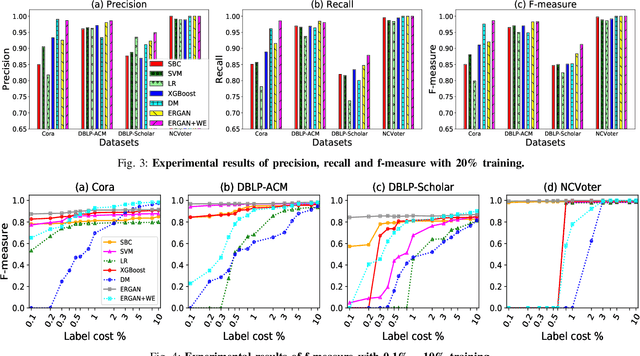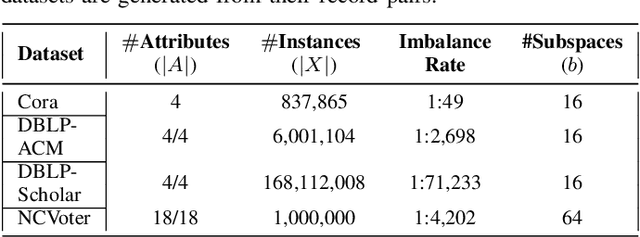Erhard Rahm
Federated Learning With Individualized Privacy Through Client Sampling
Jan 29, 2025Abstract:With growing concerns about user data collection, individualized privacy has emerged as a promising solution to balance protection and utility by accounting for diverse user privacy preferences. Instead of enforcing a uniform level of anonymization for all users, this approach allows individuals to choose privacy settings that align with their comfort levels. Building on this idea, we propose an adapted method for enabling Individualized Differential Privacy (IDP) in Federated Learning (FL) by handling clients according to their personal privacy preferences. By extending the SAMPLE algorithm from centralized settings to FL, we calculate client-specific sampling rates based on their heterogeneous privacy budgets and integrate them into a modified IDP-FedAvg algorithm. We test this method under realistic privacy distributions and multiple datasets. The experimental results demonstrate that our approach achieves clear improvements over uniform DP baselines, reducing the trade-off between privacy and utility. Compared to the alternative SCALE method in related work, which assigns differing noise scales to clients, our method performs notably better. However, challenges remain for complex tasks with non-i.i.d. data, primarily stemming from the constraints of the decentralized setting.
Multi-Layer Privacy-Preserving Record Linkage with Clerical Review based on gradual information disclosure
Dec 05, 2024



Abstract:Privacy-Preserving Record linkage (PPRL) is an essential component in data integration tasks of sensitive information. The linkage quality determines the usability of combined datasets and (machine learning) applications based on them. We present a novel privacy-preserving protocol that integrates clerical review in PPRL using a multi-layer active learning process. Uncertain match candidates are reviewed on several layers by human and non-human oracles to reduce the amount of disclosed information per record and in total. Predictions are propagated back to update previous layers, resulting in an improved linkage performance for non-reviewed candidates as well. The data owners remain in control of the amount of information they share for each record. Therefore, our approach follows need-to-know and data sovereignty principles. The experimental evaluation on real-world datasets shows considerable linkage quality improvements with limited labeling effort and privacy risks.
Assessing the Impact of Image Dataset Features on Privacy-Preserving Machine Learning
Sep 02, 2024



Abstract:Machine Learning (ML) is crucial in many sectors, including computer vision. However, ML models trained on sensitive data face security challenges, as they can be attacked and leak information. Privacy-Preserving Machine Learning (PPML) addresses this by using Differential Privacy (DP) to balance utility and privacy. This study identifies image dataset characteristics that affect the utility and vulnerability of private and non-private Convolutional Neural Network (CNN) models. Through analyzing multiple datasets and privacy budgets, we find that imbalanced datasets increase vulnerability in minority classes, but DP mitigates this issue. Datasets with fewer classes improve both model utility and privacy, while high entropy or low Fisher Discriminant Ratio (FDR) datasets deteriorate the utility-privacy trade-off. These insights offer valuable guidance for practitioners and researchers in estimating and optimizing the utility-privacy trade-off in image datasets, helping to inform data and privacy modifications for better outcomes based on dataset characteristics.
Graph-based Active Learning for Entity Cluster Repair
Jan 26, 2024Abstract:Cluster repair methods aim to determine errors in clusters and modify them so that each cluster consists of records representing the same entity. Current cluster repair methodologies primarily assume duplicate-free data sources, where each record from one source corresponds to a unique record from another. However, real-world data often deviates from this assumption due to quality issues. Recent approaches apply clustering methods in combination with link categorization methods so they can be applied to data sources with duplicates. Nevertheless, the results do not show a clear picture since the quality highly varies depending on the configuration and dataset. In this study, we introduce a novel approach for cluster repair that utilizes graph metrics derived from the underlying similarity graphs. These metrics are pivotal in constructing a classification model to distinguish between correct and incorrect edges. To address the challenge of limited training data, we integrate an active learning mechanism tailored to cluster-specific attributes. The evaluation shows that the method outperforms existing cluster repair methods without distinguishing between duplicate-free or dirty data sources. Notably, our modified active learning strategy exhibits enhanced performance when dealing with datasets containing duplicates, showcasing its effectiveness in such scenarios.
Generating Synthetic Health Sensor Data for Privacy-Preserving Wearable Stress Detection
Jan 24, 2024Abstract:Smartwatch health sensor data is increasingly utilized in smart health applications and patient monitoring, including stress detection. However, such medical data often comprises sensitive personal information and is resource-intensive to acquire for research purposes. In response to this challenge, we introduce the privacy-aware synthetization of multi-sensor smartwatch health readings related to moments of stress. Our method involves the generation of synthetic sequence data through Generative Adversarial Networks (GANs), coupled with the implementation of Differential Privacy (DP) safeguards for protecting patient information during model training. To ensure the integrity of our synthetic data, we employ a range of quality assessments and monitor the plausibility between synthetic and original data. To test the usefulness, we create private machine learning models on a commonly used, albeit small, stress detection dataset, exploring strategies for enhancing the existing data foundation with our synthetic data. Through our GAN-based augmentation methods, we observe improvements in model performance, both in non-private (0.45% F1) and private (11.90-15.48% F1) training scenarios. We underline the potential of differentially private synthetic data in optimizing utility-privacy trade-offs, especially with limited availability of real training samples.
Construction of Knowledge Graphs: State and Challenges
Feb 22, 2023Abstract:With knowledge graphs (KGs) at the center of numerous applications such as recommender systems and question answering, the need for generalized pipelines to construct and continuously update such KGs is increasing. While the individual steps that are necessary to create KGs from unstructured (e.g. text) and structured data sources (e.g. databases) are mostly well-researched for their one-shot execution, their adoption for incremental KG updates and the interplay of the individual steps have hardly been investigated in a systematic manner so far. In this work, we first discuss the main graph models for KGs and introduce the major requirement for future KG construction pipelines. Next, we provide an overview of the necessary steps to build high-quality KGs, including cross-cutting topics such as metadata management, ontology development, and quality assurance. We then evaluate the state of the art of KG construction w.r.t the introduced requirements for specific popular KGs as well as some recent tools and strategies for KG construction. Finally, we identify areas in need of further research and improvement.
Privacy in Practice: Private COVID-19 Detection in X-Ray Images
Nov 21, 2022



Abstract:Machine learning (ML) can help fight the COVID-19 pandemic by enabling rapid screening of large volumes of chest X-ray images. To perform such data analysis while maintaining patient privacy, we create ML models that satisfy Differential Privacy (DP). Previous works exploring private COVID-19 ML models are in part based on small or skewed datasets, are lacking in their privacy guarantees, and do not investigate practical privacy. In this work, we therefore suggest several improvements to address these open gaps. We account for inherent class imbalances in the data and evaluate the utility-privacy trade-off more extensively and over stricter privacy budgets than in previous work. Our evaluation is supported by empirically estimating practical privacy leakage through actual attacks. Based on theory, the introduced DP should help limit and mitigate information leakage threats posed by black-box Membership Inference Attacks (MIAs). Our practical privacy analysis is the first to test this hypothesis on the COVID-19 detection task. In addition, we also re-examine the evaluation on the MNIST database. Our results indicate that based on the task-dependent threat from MIAs, DP does not always improve practical privacy, which we show on the COVID-19 task. The results further suggest that with increasing DP guarantees, empirical privacy leakage reaches an early plateau and DP therefore appears to have a limited impact on MIA defense. Our findings identify possibilities for better utility-privacy trade-offs, and we thus believe that empirical attack-specific privacy estimation can play a vital role in tuning for practical privacy.
EAGER: Embedding-Assisted Entity Resolution for Knowledge Graphs
Jan 15, 2021



Abstract:Entity Resolution (ER) is a constitutional part for integrating different knowledge graphs in order to identify entities referring to the same real-world object. A promising approach is the use of graph embeddings for ER in order to determine the similarity of entities based on the similarity of their graph neighborhood. The similarity computations for such embeddings translates to calculating the distance between them in the embedding space which is comparatively simple. However, previous work has shown that the use of graph embeddings alone is not sufficient to achieve high ER quality. We therefore propose a more comprehensive ER approach for knowledge graphs called EAGER (Embedding-Assisted Knowledge Graph Entity Resolution) to flexibly utilize both the similarity of graph embeddings and attribute values within a supervised machine learning approach. We evaluate our approach on 23 benchmark datasets with differently sized and structured knowledge graphs and use hypothesis tests to ensure statistical significance of our results. Furthermore we compare our approach with state-of-the-art ER solutions, where our approach yields competitive results for table-oriented ER problems and shallow knowledge graphs but much better results for deeper knowledge graphs.
ErGAN: Generative Adversarial Networks for Entity Resolution
Dec 18, 2020



Abstract:Entity resolution targets at identifying records that represent the same real-world entity from one or more datasets. A major challenge in learning-based entity resolution is how to reduce the label cost for training. Due to the quadratic nature of record pair comparison, labeling is a costly task that often requires a significant effort from human experts. Inspired by recent advances of generative adversarial network (GAN), we propose a novel deep learning method, called ErGAN, to address the challenge. ErGAN consists of two key components: a label generator and a discriminator which are optimized alternatively through adversarial learning. To alleviate the issues of overfitting and highly imbalanced distribution, we design two novel modules for diversity and propagation, which can greatly improve the model generalization power. We have conducted extensive experiments to empirically verify the labeling and learning efficiency of ErGAN. The experimental results show that ErGAN beats the state-of-the-art baselines, including unsupervised, semi-supervised, and unsupervised learning methods.
LEAPME: Learning-based Property Matching with Embeddings
Oct 05, 2020



Abstract:Data integration tasks such as the creation and extension of knowledge graphs involve the fusion of heterogeneous entities from many sources. Matching and fusion of such entities require to also match and combine their properties (attributes). However, previous schema matching approaches mostly focus on two sources only and often rely on simple similarity measurements. They thus face problems in challenging use cases such as the integration of heterogeneous product entities from many sources. We therefore present a new machine learning-based property matching approach called LEAPME (LEArning-based Property Matching with Embeddings) that utilizes numerous features of both property names and instance values. The approach heavily makes use of word embeddings to better utilize the domain-specific semantics of both property names and instance values. The use of supervised machine learning helps exploit the predictive power of word embeddings. Our comparative evaluation against five baselines for several multi-source datasets with real-world data shows the high effectiveness of LEAPME. We also show that our approach is even effective when training data from another domain (transfer learning) is used.
 Add to Chrome
Add to Chrome Add to Firefox
Add to Firefox Add to Edge
Add to Edge